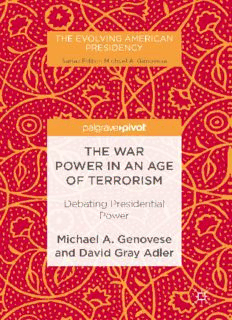
The War Power in an Age of Terrorism: Debating Presidential Power PDF
Preview The War Power in an Age of Terrorism: Debating Presidential Power
The Evolving American Presidency Series Editor Michael A. Genovese Loyola Marymount University Los Angeles, California USA This series is stimulated by the clash between the presidency as invented and the presidency as it has developed. Over time, the presidency has evolvedandgrowninpower,expectations,responsibilities,andauthority. Addingtothepowerofthepresidencyhavebeenwars,crises,depressions, industrialization. The importance and power of the modern presidency makes understanding it so vital. How presidents resolve challenges and paradoxesofhighexpectationswithlimitedconstitutionalresourcesisthe central issue in modern governance and the central theme of this book series. More information aboutthisseries at http://www.springer.com/series/14437 MichaelA.Genovese(cid:129)DavidGrayAdler The War Power in an Age of Terrorism Debating Presidential Power Michael A.Genovese DavidGray Adler Political Science President, Alturas Institute Loyola MarymountUniversity Alturas, Idaho, USA Los Angeles and California Lecturer, University ofIdaho USA CollegeofLaw,IdahoFalls,Idaho,USA TheEvolvingAmericanPresidency ISBN978-1-137-59353-5 ISBN978-1-137-57931-7(eBook) DOI10.1057/978-1-137-57931-7 LibraryofCongressControlNumber:2016956866 ©TheEditor(s)(ifapplicable)andTheAuthor(s)2017 This work is subject to copyright. All rights are solely and exclusively licensed by the Publisher,whetherthewholeorpartofthematerialisconcerned,specificallytherightsof translation, reprinting, reuse of illustrations, recitation, broadcasting, reproduction on microfilms or in any other physical way, and transmission or information storage and retrieval,electronicadaptation,computersoftware,orbysimilarordissimilarmethodology nowknownorhereafterdeveloped. Theuseofgeneraldescriptivenames,registerednames,trademarks,servicemarks,etc.inthis publicationdoesnotimply,evenintheabsenceofaspecificstatement,thatsuchnamesare exemptfromtherelevantprotectivelawsandregulationsandthereforefreeforgeneraluse. Thepublisher,theauthorsandtheeditorsaresafetoassumethattheadviceandinformation in this book are believed to be true and accurate at the date of publication. Neither the publishernortheauthorsortheeditorsgiveawarranty,expressorimplied,withrespectto thematerialcontainedhereinorforanyerrorsoromissionsthatmayhavebeenmade. Coverillustration:PatternadaptedfromanIndiancottonprintproducedinthe19thcentury Printedonacid-freepaper ThisPalgraveMacmillanimprintispublishedbySpringerNature TheregisteredcompanyisNatureAmericaInc. Theregisteredcompanyaddressis:1NewYorkPlaza,NewYork,NY10004,U.S.A. From Michael Thisbookis dedicated to Gaby,who brought mepeace From David Thisbook isdedicated to Tally,who continues to amazeme P A REFACE AND CKNOWLEDGMENTS In wartime, the Constitution needs all the friends it can get. The fog of warcloudsourvision,andweoftenactbeforewethink.Orweactbefore we have sufficient information. Thus, we often overreact, or rush to judgment. Such was the case in the aftermath of 9/11. In our effort to fight terrorism,weoverstepped,puttingkeyconstitutionalguaranteesofrights injeopardy.Wealsoembracedanuclear,imperialpresidency,andpolicies that backfired on us, and unleashed a torrent of wicked problems from which westill suffer. To be fair, the people in the White House did not know if the initial attackon9/11wasthebeginningofamoremassiveattack;theyoperated in a world of uncertainty and confusion; and believed another major assault on the United States might be imminent. Put yourself in their shoes. Would you have acted in a measured, thoughtful way, fully con- scious of protecting rights of citizens, or would you have been primarily concernedwithpreventinganotherattackandsavingthelivesofcitizens? Much ink has been spilled blaming, first, President Bush, and later President Obama for their excessive zeal in fighting the threats of terror- ism. We need not engage that argument, and assign blame. The concern hereistolookafreshatthewarpowersintheUnitedStatesasweemerge outof our post-9/11fog. In an age of terrorism, does, should, can, our original constitutional structure for declaring war still guide us? Is our eighteenth-century Constitutionhopelesslyoutofdateforatwenty-first-centurysuperpower? So let us revisit the founders of our system to glean insights into their vii viii PREFACEANDACKNOWLEDGMENTS goals,seehowthatsystemoperatesinourworld,andask,“Shouldwestill be guidedby theirmodel?” There is no more important decision governments make than to go to war. Asking citizens to risk their lives, committing the resources of the nation, jeopardizing the very existence of the nation, is a monumental decision fraught with consequences of the highest magnitude. How does the United States enter into war? Who decides? On what basis? Within whatconfines? This is a book about how we go to war. We present the ideal and constitutional (the U.S. Congress authorizes war, either by a formal declarationor byjoint resolution),andthe realandpolitical (mostoften, the president merely acts, takingthe nation intowar). Wewillalsolookatthehowthepost–September11,2001,waragainst terrorism has placed new strains on the war powers, and how the United States has respondedto thisnew threat. Intheend,wewillarguethatatleastsincetheendofWorldWarII,the war power has been hijacked by an Imperial Presidency, and often ceded to the executive by a feckless Congress. Unfortunately, an untutored American public has mistakenly attributed to the president the authority to initiate war, an error that has been promoted by an equally untutored press. For the sake of constitutionalism, the rule of law, the separation of powers, and our system of checks and balances, we had better turn this aroundand“getitright,”orelsethevitalityandintegrityofourconstitu- tional republicare injeopardy. The format of this book is to present an argument over the role of constitutionalism and presidential power in an age of terrorism. One author takes the position that the original war declaring power of Congress needs to be updated to better suit a twenty-first-century super- power.Theotherauthorbelievesthatwecanandshouldholdtruetothe visionoftheFramers,andcontinuetoinvestinthepowertoauthorizewar in the hands of the Congress. We present this friendly argument as a vehicle for readers to make more thoughtful and informed decisions on whoshall take the nationinto war. Asyouwillsee,theauthorsdifferregardingjustwhatshouldbedone—if anything—about the war powers in the United States. One author (Genovese) argues that a twenty-first-century superpower needs a more streamlined—modern—system of going to war. The other author (Adler) PREFACEANDACKNOWLEDGMENTS ix isastaunchdefenderoftheFramers’modelandarguesthatitsvaluesareas compelling today as they were at the time of the framing of the Constitution. If there is friendly disagreement, there is also a place where the two authors agree. And it is in that area of agreement—retroactive justification—thatbothauthorsfindcommongroundinacomplexworld. OnemorethingwebothagreeonisthatweAmericanshaveyettotake acold,hardlookatconstitutionalisminanageofterrorism.Wehopethis booktakes usone stepcloser todoing justthat. MichaelA.Genovesethanksthestudentswhohelpedmanagehimand themanuscriptpreparation:JohnPickhaver,DaniJordan,andJakeWeitz, who were always helpful, usually cheerful, and chronically hardworking. David Gray Adler thanks hismany students andcolleagues over the years atIdahoStateUniversityandtheUniversityofIdahoCollegeofLaw,for listeningtohisviewsonthewarpower;theIdahoHumanitiesCouncilfor generous support of this project; the Board of Directors of the Alturas Institutefor theirenthusiasm,vision,encouragement, and support:Steve Carr, Doug Oppenheimer, Clay Morgan, Barbara Morgan, Caroline Heldman, Jeff Neiswanger, Mark Young, and Tim Hopkins; Kelli Jenkins for her superb administrative skills, and Penni Englert, for her wonderfulclerical assistance. C ONTENTS 1 WarandAmerican Democracy 1 Introduction 2 The Predicate 3 The Problem 5 Tamingthe American Prince 6 Inventinga Presidency 10 Defending theConstitution 18 The Ratification Debate 20 The Riseof PresidentialPower 24 EarlyPractice: TheWarPowers inAction 27 9/11:Everything Changed 34 Inter ArmaEnimSilent Leges orFullCircle and theReturn of theKing 39 Revolution inPolicy 42 Things Change 46 The Presidency,ForeignPolicy, and War 48 The Power ofContext 49 2 Prescriptionsfor a NewAge 53 What to Do? 53 Constitutional Change 56 Old Winein NewBottlesJustWon’t Do: Rethinkingthe War Powers inan Ageof Terrorism 58 xi
